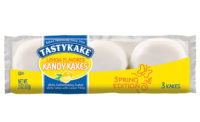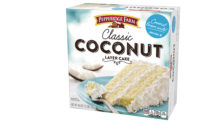When it’s time for dessert, consumers tend to set aside better-for-you notions and let themselves enjoy a small slice of indulgence. As such, traditional cake, pie and cheesecake products continue to sell well.
Overview | Bread | Tortillas | Sweet Goods | Snack Cakes | Pizza | Desserts | Cookies | Buns & Rolls | Bars
But even desserts aren’t immune to the prevailing winds of clean label, gluten-free, portion control and other health halos—and both unequivocally indulgent and specialized approaches to product development will continue to find a willing audience. Meanwhile, flavor trends ever evolve, and innovative ingredient touches continue to cultivate appeal.
Market data
The desserts segment—with a focus on cakes, pies and cheesecakes—is a mature market, with perennially strong sales. These products continued to show positive performance for the 52 weeks ending April 19, 2015, with the cakes, pies and cheesecakes all posting upward numbers. Cakes rose 4.21 percent in dollar sales to $1.2 billion for the category, while the pies category was up 6.72 percent in dollar sales, taking in $348.8 million, per IRI, Chicago. Frozen pies also gained ground, up 2.18 percent in dollar sales, with sales of $533.8 million. Refrigerated cheesecakes gained 2.65 percent in dollar sales to $223.1 million, while frozen cheesecakes saw a small gain of 0.69 percent in dollar sales to $133.2 million.
Private label continues to dominate the desserts segment, with top sales slots in cakes, pies and refrigerated and frozen cheesecakes, and only frozen pies seeing stronger national brand activity where Schwan Food Co. (Edwards, Mrs. Smith’s) , ConAgra Foods (Marie Callender’s) and Hillshire Brands (Sara Lee) beating out private label.
Looking back
Diversity in product size continues to prove an attractive product trait. In frozen pies, the Schwan Food Co. brand Edwards Singles saw 7.68 percent dollar share growth, per IRI. The brand offers both full pies and products containing two slices of pie.
“I continue to see all kinds of portion-control sizes of pies,” says Linda Hoskins, executive director, American Pie Council, Lake Forest, IL. This includes small, 3-inch or 6-inch pies that are individually wrapped and sealed, as well as hand pies, slices and pie bites.
“Pies have historically been a single-serve item—almost exclusively,” says Byard T. Ebling, vice president, sales and marketing, JTM Foods, Erie, PA. “If you look at syndicated data, sweet baked goods do about 60 percent of their volume in multipacks. This is real white space for the pie category. The heavy-indexing age groups move down to more family-type demographics. The 2-ounce portion is also more kid-friendly. Moms have told us they also feel better about pies, because they are made with real fruit.”
The company’s JJ’s Bakery Tid-Bits Mini Pie line was released at the end of 2013. The company also maintains a strong private-label business. “Private label is increasing very dramatically in the marketplace,” he says.
Lance Aasness, executive vice president, Hinds-Bock Corp., Bothell, WA, also notes that he continues to see a focus on portion-controlled items, such as mini desserts.
“The pie category is fairly stable,” says Eric Riggle, vice president, Rademaker USA, Hudson, OH, “not strong growth, but not shrinking, either. We see product sizes getting smaller, as well as handheld pies becoming more and more popular.”
Product developers have also explored portion sizes designed for sharing. “Our research shows today’s consumer craves retro desserts with on-trend flavors and seeks out preportioned desserts that satisfy both the individual indulgence-seeker and those preferring sharable desserts,” says Cindy Nagle, senior manager, strategic innovation, Tyson Food Service, Springdale, AR. The company’s new Bistro Collection features individual Bundt cakes, designed to split between two people, in flavors like Chocolate with Chocolate Ganache, Vanilla Bean with Raspberry, Chocolate Pecan with Salted Caramel, and Boston Crème with Chocolate, ranging from 3.25 to 3.75 ounces each. She notes that the line “responds to this growing demand for dessert nostalgia and rise in mini cakes popularity.”
Classic dessert baker Golden Boy Pies—featured in the January 2015 issue of Snack Food & Wholesale Bakery—has also found success with its mini Bundt cakes in flavors like chocolate, red velvet and carrot.
“Desserts are a treat, and consumers look forward to indulging by monitoring the portion size,” says Debbie Littmann Marchok, senior marketing manager, Eli’s Cheesecake, Chicago. “The novelty and visual appeal of miniatures falls right in line.” Eli’s began offering Mini Pies in apple and cherry, as well as a Brown Sugar Walnut Hand Pie and a Chocolate Hazelnut Hand Pie, in 2013. The company also offers Cuties, “our version of mini dessert bars,” she says, in flavors like Fudge Brownie, Raspberry Swirl Cheesecake, 7 Layer Bar and Original Plain Cheesecake.
Fillo Factory, which offers single-serve frozen pies wrapped in fillo dough, saw a tremendous sales boost over the 52 weeks ending April 19, 2015, per IRI, with an astounding 40,075.87 percent dollar sales growth. Its dessert offerings include an Apple-Cinnamon Turnovers, Apple-Cinnamon Strudel, Cheese & Blueberry Strudel, Cheese & Cherry Strudel, Walnut Baklava, Chocolate Baklava and Raspberry Baklava.
Flavors across desserts are also seeing increased diversity. “I see more tropical fruits than ever and more fruit combinations,” says Hoskins. “Of course, the pies that address dietary concerns are becoming more and more popular,” including no-sugar-added (NSA) and gluten-free.
As in other areas of bakery, gluten-free desserts have trended forward. At the 2015 National Restaurant Association show, The Original Cakerie, Delta, British Columbia, was honored with a FABI Award for its gluten-free Dreamin’ of Chocolate and Dreamin’ of Strawberries layer cakes, distributed to both retail and foodservice customers.
Looking forward
The linchpin in any pie is the crust. “The crust is most often the key to producing a high-quality pie,” says Hoskins. “To make a great, flakey crust like Grandma used to make with her rolling pin, equipment with cross sheeting could be the answer,” she says.
“In today’s market, in order to compete, you need to produce the highest-quality product at the lowest cost,” says Riggle. “You do this by utilizing equipment that is efficient, that gives the highest product yield and with the least amount of downtime.”
Aasness notes that with producers focusing on their cost of manufacturing, quality, yield and production to meet the consumer demand for portion-controlled products, the need for industrial automatic depositing lines has grown.
For bakers who operate in both retail and foodservice, impending regulatory changes will likely dictate new approaches to calorie control. “With the new law to publish calorie count on menus for restaurants with 20 or more units by the end of 2015, we expect some restaurants to review desserts not only for ingredients, but for portion size to achieve a ‘reasonable’ calorie count,” says Marchok. “Offering a variety of portion sizes provides the operator the ability to select dessert options to fit their menu needs.”
Select geographical markets also show promise for desserts. “We are excited about the opportunity in the western half of the U.S.,” says Ebling. “Generally speaking, the West is underdeveloped.” He notes that the ability to freeze and ship pies in a safe and effective manner opens up a national sales footprint.
As is the case across the entire food industry today, consumers are growing more interested in every detail surrounding desserts. “As consumers continue to inquire about the origin of the food they eat, the ingredients in their food and the values of the companies that produce the food, we find the notable developments pertaining to their need for information,” says Marchok. “The focus on the source of food and ingredients is predominant. Consumers want to read an ingredient statement and be able to understand the ingredient listing. They want to know where the ingredients are from and, moreover, how the ingredients were grown or fed or processed.”
Beyond portion control, this is a key way dessert bakers can add a health halo to products. “Cleaner labels mean ‘healthier’ to the consumer, even with desserts,” says Susan Dixon, sales manager, Richmond Baking Co., Richmond, IN. The focus here, she says, continues on removing partially hydrogenated oils, high fructose corn syrup, artificial colors and flavors, and as many allergens as possible.
These dietary concerns often connect to gluten-free—and even vegan in some markets. “The focus on the ingredients permeates throughout the food chain, from grower to manufacturer to distributor to retailer to consumer,” says Marchok. “We bake a Salted Caramel Cheesecake made with gluten-free ingredients to meet the lifestyle needs of a growing niche of consumers.”
The bakery also offers a vegan cheesecake, with the impetus coming from “the country’s growing awareness of healthier eating, the fact that the vegan market has doubled over the past five years, and over 100 million people, vegans and non-vegans, are choosing more plant-based foods,” she says. The resultant product edges into “free-from” territory, as it’s dairy-free, egg-free and cholesterol-free, as well as certified vegan and kosher. Available flavors include Belgian Chocolate and Carrot Cake.
“Product categories meeting special lifestyle needs, from gluten-free to vegan to sugar-free to fat-free, will continue to have a place in the marketplace,” says Marchok. “Across these categories, artificial ingredients and colors will be on the ‘do not use’ list for consumers.” For Eli’s, this attention to ingredient detail extends to working with its fruit supplier to source sulfite-free apples.
“The source of the food is more than just ingredients,” says Marchok. “Consumers want to know about the company that makes the product and sells the product. They want to know about the company’s values, from environmental concerns to community support to employment practices.” The tofu the company uses in its vegan cheesecakes comes from a local Chicago producer, and the wildflower honey that goes into some products is produced by students from the Chicago High School for Agricultural Sciences.
And while truly better-for-you approaches aren’t prevalent in an indulgent segment like desserts, ingredient choice can help products lean in that direction. Yogurt, in particular, can imbue dessert products with nutrition-forward, better-for-you appeal. Love & Quiches now offers Greek Yogurt Cheesecake in plain and blueberry. The yogurt adds protein to the mix, while reducing fat and calorie content.
“Pies are growing at a rate that is faster than the sweet baked goods category as a whole,” says Ebling. “Consumers are open to a wider variety of flavors and special-edition pies.”
With the right combination of product dynamics, bakers of desserts today can often find sweet success by offering just a small slice of flavorful indulgence.
Overview | Bread | Tortillas | Sweet Goods | Snack Cakes | Pizza | Desserts | Cookies | Buns & Rolls | Bars














